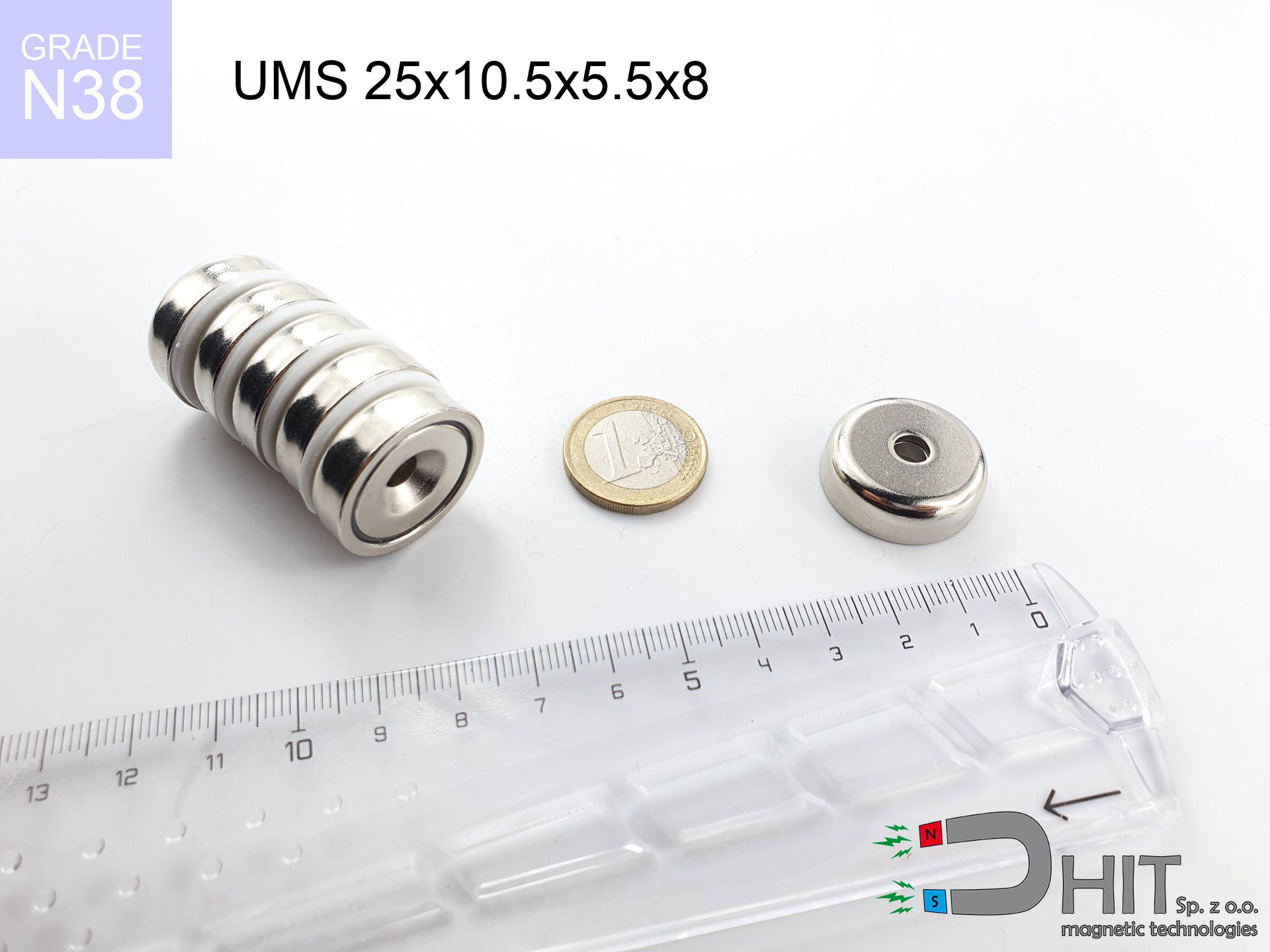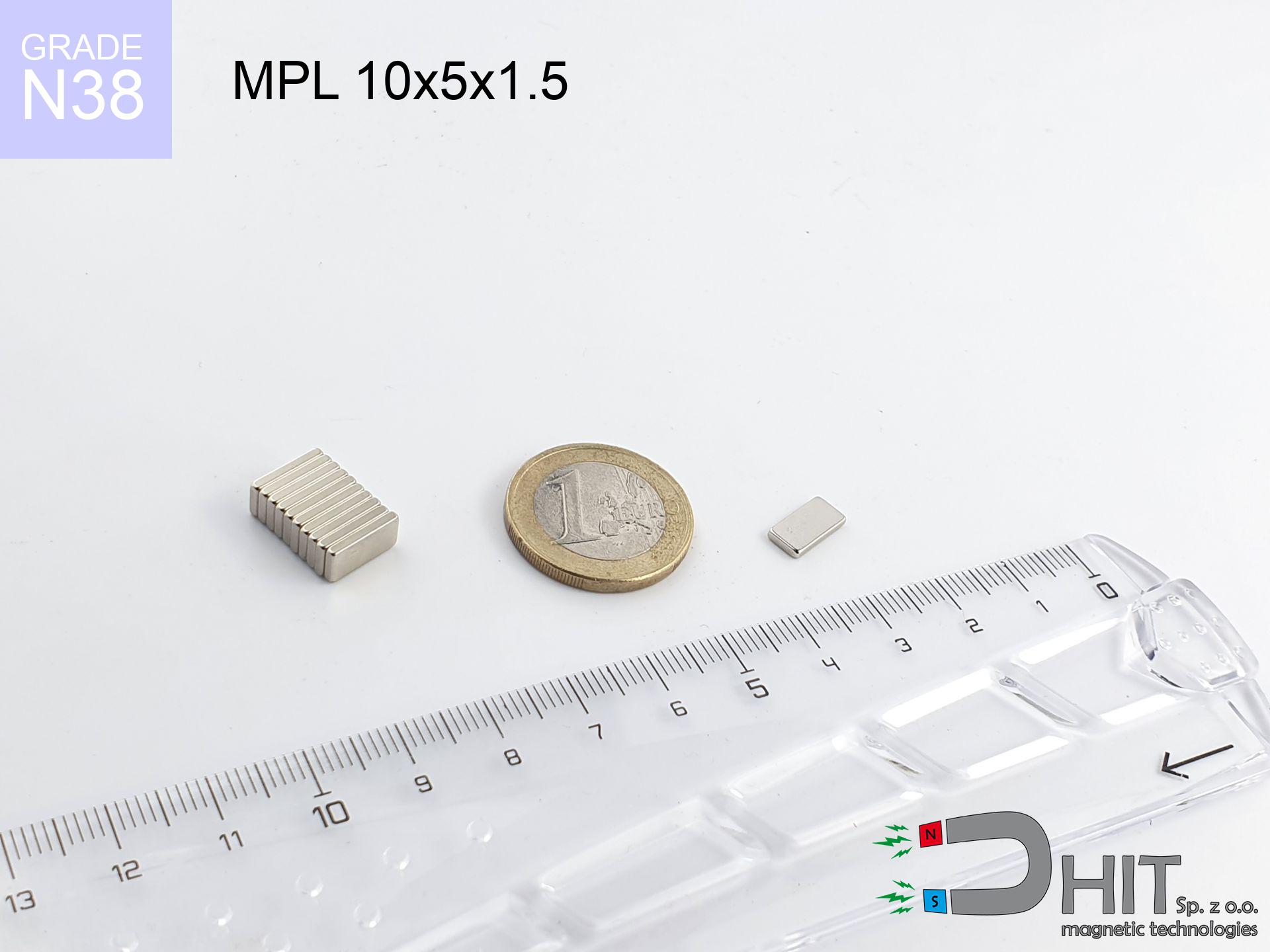UMH 32x8x46 [M6] / N38 - magnetic holder with hook
magnetic holder with hook
Catalog no 310427
GTIN/EAN: 5906301814566
Diameter Ø
32 mm [±1 mm]
Height
46 mm [±1 mm]
Height
8 mm [±1 mm]
Weight
53 g
Magnetization Direction
↑ axial
Load capacity
38.00 kg / 372.65 N
Coating
[NiCuNi] Nickel
22.14 ZŁ with VAT / pcs + price for transport
18.00 ZŁ net + 23% VAT / pcs
bulk discounts:
Need more?Do you have a dilemma?
Give us a call
+48 888 99 98 98
or let us know through
contact form
the contact page.
Parameters as well as structure of magnetic components can be analyzed using our
power calculator.
Order by 14:00 and we’ll ship today!
UMH 32x8x46 [M6] / N38 - magnetic holder with hook
Specification / characteristics UMH 32x8x46 [M6] / N38 - magnetic holder with hook
| properties | values |
|---|---|
| Cat. no. | 310427 |
| GTIN/EAN | 5906301814566 |
| Production/Distribution | Dhit sp. z o.o. |
| Country of origin | Poland / China / Germany |
| Customs code | 85059029 |
| Diameter Ø | 32 mm [±1 mm] |
| Height | 46 mm [±1 mm] |
| Height | 8 mm [±1 mm] |
| Weight | 53 g |
| Magnetization Direction | ↑ axial |
| Load capacity ~ ? | 38.00 kg / 372.65 N |
| Coating | [NiCuNi] Nickel |
| Manufacturing Tolerance | ±1 mm |
Magnetic properties of material N38
| properties | values | units |
|---|---|---|
| remenance Br [min. - max.] ? | 12.2-12.6 | kGs |
| remenance Br [min. - max.] ? | 1220-1260 | mT |
| coercivity bHc ? | 10.8-11.5 | kOe |
| coercivity bHc ? | 860-915 | kA/m |
| actual internal force iHc | ≥ 12 | kOe |
| actual internal force iHc | ≥ 955 | kA/m |
| energy density [min. - max.] ? | 36-38 | BH max MGOe |
| energy density [min. - max.] ? | 287-303 | BH max KJ/m |
| max. temperature ? | ≤ 80 | °C |
Physical properties of sintered neodymium magnets Nd2Fe14B at 20°C
| properties | values | units |
|---|---|---|
| Vickers hardness | ≥550 | Hv |
| Density | ≥7.4 | g/cm3 |
| Curie Temperature TC | 312 - 380 | °C |
| Curie Temperature TF | 593 - 716 | °F |
| Specific resistance | 150 | μΩ⋅cm |
| Bending strength | 250 | MPa |
| Compressive strength | 1000~1100 | MPa |
| Thermal expansion parallel (∥) to orientation (M) | (3-4) x 10-6 | °C-1 |
| Thermal expansion perpendicular (⊥) to orientation (M) | -(1-3) x 10-6 | °C-1 |
| Young's modulus | 1.7 x 104 | kg/mm² |
Elemental analysis
| iron (Fe) | 64% – 68% |
| neodymium (Nd) | 29% – 32% |
| boron (B) | 1.1% – 1.2% |
| dysprosium (Dy) | 0.5% – 2.0% |
| coating (Ni-Cu-Ni) | < 0.05% |
Environmental data
| recyclability (EoL) | 100% |
| recycled raw materials | ~10% (pre-cons) |
| carbon footprint | low / zredukowany |
| waste code (EWC) | 16 02 16 |
Check out more proposals
Strengths and weaknesses of neodymium magnets.
Benefits
- They virtually do not lose strength, because even after ten years the performance loss is only ~1% (according to literature),
- They are resistant to demagnetization induced by presence of other magnetic fields,
- A magnet with a shiny silver surface is more attractive,
- They show high magnetic induction at the operating surface, which improves attraction properties,
- Thanks to resistance to high temperature, they can operate (depending on the shape) even at temperatures up to 230°C and higher...
- Thanks to the possibility of flexible shaping and adaptation to custom needs, magnetic components can be manufactured in a wide range of geometric configurations, which makes them more universal,
- Fundamental importance in electronics industry – they serve a role in magnetic memories, brushless drives, precision medical tools, also technologically advanced constructions.
- Compactness – despite small sizes they generate large force, making them ideal for precision applications
Cons
- At strong impacts they can break, therefore we recommend placing them in steel cases. A metal housing provides additional protection against damage, as well as increases the magnet's durability.
- Neodymium magnets decrease their power under the influence of heating. As soon as 80°C is exceeded, many of them start losing their power. Therefore, we recommend our special magnets marked [AH], which maintain stability even at temperatures up to 230°C
- They oxidize in a humid environment. For use outdoors we suggest using waterproof magnets e.g. in rubber, plastic
- We recommend cover - magnetic mechanism, due to difficulties in producing threads inside the magnet and complicated forms.
- Possible danger to health – tiny shards of magnets are risky, when accidentally swallowed, which gains importance in the context of child health protection. Furthermore, small elements of these devices can disrupt the diagnostic process medical in case of swallowing.
- Higher cost of purchase is one of the disadvantages compared to ceramic magnets, especially in budget applications
Holding force characteristics
Magnetic strength at its maximum – what contributes to it?
- using a base made of high-permeability steel, serving as a magnetic yoke
- with a cross-section minimum 10 mm
- with a surface perfectly flat
- with total lack of distance (without paint)
- for force acting at a right angle (in the magnet axis)
- at ambient temperature approx. 20 degrees Celsius
Lifting capacity in real conditions – factors
- Space between magnet and steel – every millimeter of distance (caused e.g. by varnish or unevenness) diminishes the pulling force, often by half at just 0.5 mm.
- Force direction – note that the magnet holds strongest perpendicularly. Under sliding down, the capacity drops drastically, often to levels of 20-30% of the maximum value.
- Substrate thickness – to utilize 100% power, the steel must be sufficiently thick. Paper-thin metal limits the attraction force (the magnet "punches through" it).
- Steel grade – the best choice is high-permeability steel. Cast iron may generate lower lifting capacity.
- Smoothness – ideal contact is possible only on polished steel. Any scratches and bumps create air cushions, weakening the magnet.
- Temperature – heating the magnet results in weakening of induction. Check the maximum operating temperature for a given model.
Holding force was checked on the plate surface of 20 mm thickness, when a perpendicular force was applied, however under parallel forces the holding force is lower. Moreover, even a small distance between the magnet and the plate lowers the load capacity.
Do not overheat magnets
Monitor thermal conditions. Exposing the magnet to high heat will destroy its properties and strength.
Do not underestimate power
Before starting, check safety instructions. Sudden snapping can destroy the magnet or hurt your hand. Think ahead.
Danger to the youngest
Only for adults. Tiny parts pose a choking risk, causing severe trauma. Keep away from children and animals.
Keep away from electronics
Be aware: neodymium magnets generate a field that interferes with sensitive sensors. Keep a safe distance from your phone, device, and navigation systems.
Safe distance
Do not bring magnets close to a purse, computer, or screen. The magnetism can permanently damage these devices and wipe information from cards.
Do not drill into magnets
Machining of NdFeB material poses a fire risk. Neodymium dust reacts violently with oxygen and is difficult to extinguish.
Allergic reactions
It is widely known that nickel (standard magnet coating) is a common allergen. If you have an allergy, prevent direct skin contact or select versions in plastic housing.
Risk of cracking
Watch out for shards. Magnets can fracture upon violent connection, ejecting shards into the air. Wear goggles.
Pacemakers
Medical warning: Neodymium magnets can turn off pacemakers and defibrillators. Stay away if you have medical devices.
Bone fractures
Protect your hands. Two powerful magnets will snap together immediately with a force of massive weight, crushing anything in their path. Exercise extreme caution!

![Magnet with hook UMH 32x8x46 [M6] / N38 Magnet with hook UMH 32x8x46 [M6] / N38](https://cdn3.dhit.pl/graphics/banners/magnet.webp)
![UMH 32x8x46 [M6] / N38 - magnetic holder with hook](https://cdn3.dhit.pl/graphics/products/umh-32x8x46-m6-xov.jpg)
![UMGW 75x33x18 [M10] GW / N38 - magnetic holder internal thread UMGW 75x33x18 [M10] GW / N38 - magnetic holder internal thread](https://cdn3.dhit.pl/graphics/products/umgw-75x33x18-m10-gw-cak.jpg)
![HH 32x7.8 [M5] / N38 - through hole magnetic holder HH 32x7.8 [M5] / N38 - through hole magnetic holder](https://cdn3.dhit.pl/graphics/products/hh-32x7.8-m5-war.jpg)



